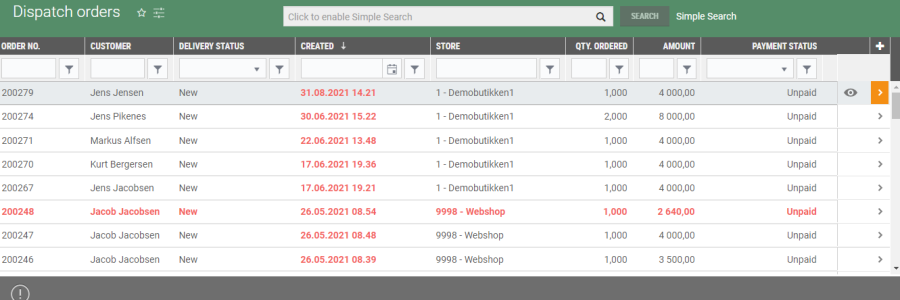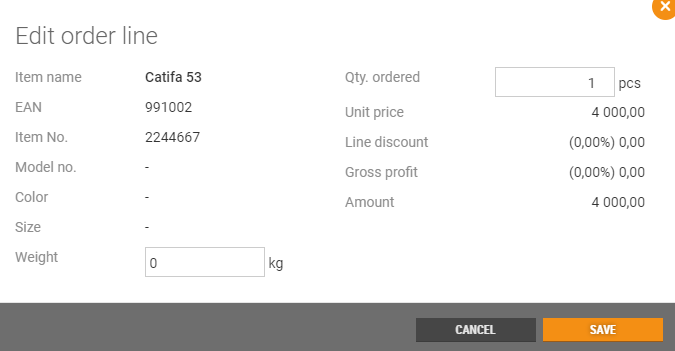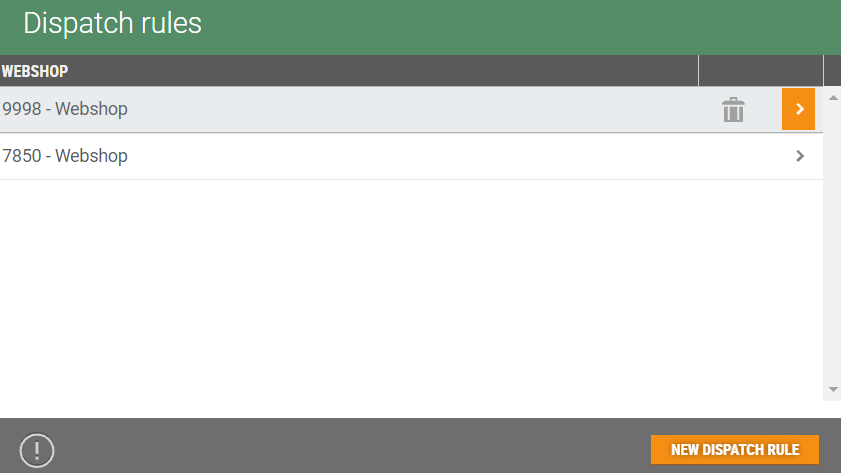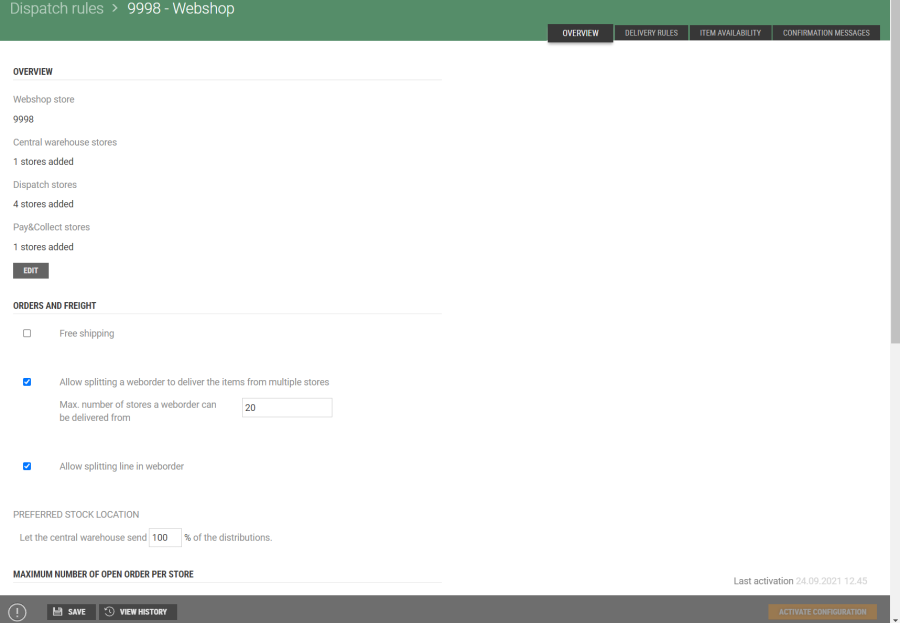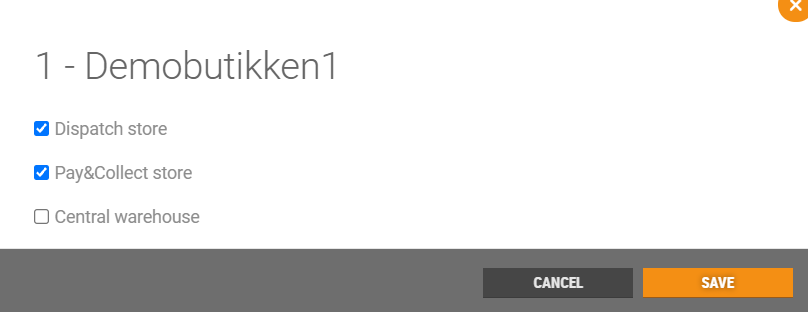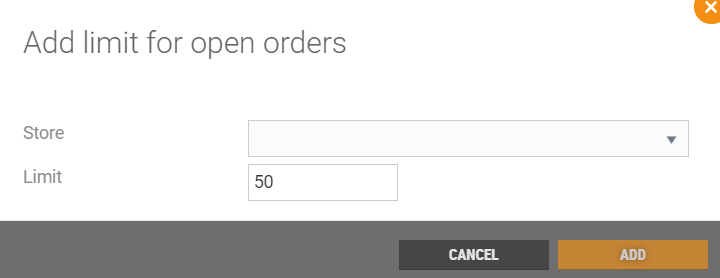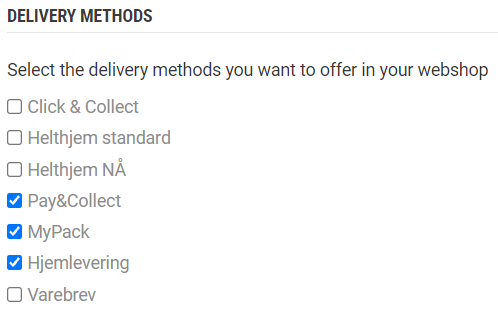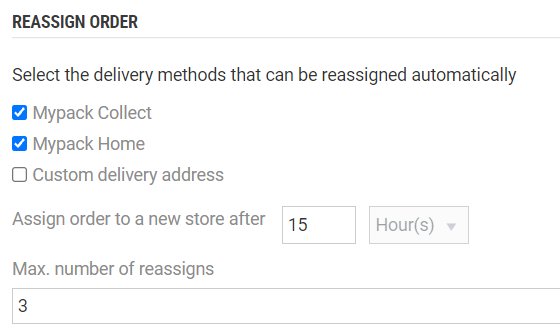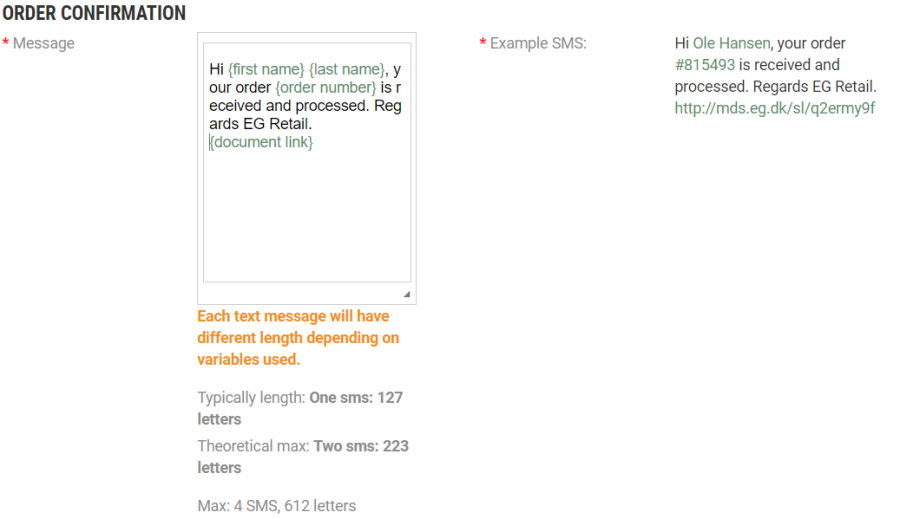Content
1 Introduction
2 Overall solution
3 Routine description - Dispatch orders
3.1 Order details
3.1.1 Cancel order
3.2 Pick orders and print shipping papers
3.3 Dispatch orders: Service center
3.3.1 Edit order line
3.3.2 Reassign
3.3.3 Reassign order line
3.3.4 Automatic reassign
3.3.5 Replace item
3.3.6 Remove item
3.4.2 Return items
3.4.3 See orders for all stores
4 Dispatch rules
4.1.1 Delete dispatch rule
4.1.2 View /change dispatch rule details
4.2 Create new dispatch rule
4.2.1 Overview
4.2.2 Delivery rules
4.2.3 Item availability
4.2.4 Confirmation messages
4.3 Dispatch Suggestion
Introduction
This document describes EG's solution for distribution of web order from more then just one stock location. The solution makes it possible for the chain to offer a wider assortment and avoid more sold out situations.
In addition, the freight time can in many cases be reduced by distribute orders from a location closer to the customer. The solution for distributing from the store assumes that the orders are prepaid (or payment is reserved) in the web shop.
The solution supports the following functionality:
- Prepaid orders that are delivered from store and warehouse to customers via carriers.
- Prepaid orders that are collected in store.
- Prepaid orders that are collected in store even if the store is missing items in the order. Missing items are sent to store from another stock location.
- Automatic assignment of web order to store or warehouse based on customers choice of delivery method, item availability and location.
- Customer communication by email or SMS.
- Notification in the cash register when an order is assigned and ready to be picked in store.
- Registration of order picking in store with a mobile handheld terminal.
- Print of fright labels on local printer in the store when an order has been picked.
- Optional automatic reassign if store reject order.
- Optional automatic deletion of order lines and order if order cannot be fulfilled anywhere. With automatic refund and notification to customer.
- SMS to customer when order is ready to be collected in store.
- Follow-up and surveillance of all orders centrally.
- Return of orders in POS or in Backoffice
- Automatic creation of internal transfers between delivering store and the web shop for items distributed from the store.
For information about how to create web orders, have a look at Web orders.
Overall solution
The solution for picking and distribution consists of the following components:
- EG POS API. Integration platform for handling shopping basket in the web shop, distributing items and prices to the front end.
- EG POS. Show notification when a new order is assigned to the store.
- InStore App. Solution for the picking process in store. Orders are available for picking in InStore App as soon as an order is assigned to the store.
- DispatchService. ContainsProvide delivery suggestions based on the cart and contains the logic for how the orders should be distributed, based on:
- Configuration/parameter setting of the service
- Item availability in the stores and on the central
- The customers selected delivery method
- Geography
- Chain Web. Viewing, following up and changing orders is handled in Chain Web. In Chain Web both stores and customer service centrally can monitor and check status on the web orders.
- Chain Classic – Master for stock.
- Dispatch Order Dashboard – KPI's and metrics to track the performance of customer order processing from inventory management all the way through to the customer.
In addition, the following external systems is included:
- DispatchService is integrated against nShift to calculate fright costs.
- E-commerce platform. Front-end for the web shop. Integrated with DispatchService and POS API
Routine description - Dispatch orders
Dispatch orders is used to monitor order status to end customer, orders that either should be picked in the store, or should be picked in the central warehouse. In addition, orders can be changed, and assigned to another store.
Different color codes on the order lines in the Dispatch orders overview gives information about if the order has been processed within parameter-controlled deadlines (see parameter overview).
User rights are assigned to different roles. The functions that the user has access to is determined by the rights defined in the roles of the user.
A store user should only see the orders for his store.
HK-user/service center should have full access to all orders with change rights.
When a new order is assigned a store by DispatchService, a notification automatically appears in the cash registers in the store.
Preview order confirmation
You can preview the order confirmation from the Dispatch order view. Click on the "eye icon" on the order line you want to preview.
Order confirmation opens in a new view. In this view you have the following choices: "Print", "Get PDF" or "Send confirmation" on e-mail or SMS.
Order details
You can view / edit order details by selecting order line for the wanted order. Select an order by double-clicking on the order line or by clicking the orange arrow to the right of the order line.
Order details view opens. Bellow you find a description of the view.
Order information is displayed at the top of the view(1), order text(2), contact details (3), and delivery address (4). Items in the picking order is displayed at the bottom of the view (5).
- Order information
Order information displays general information about the order.
- Order text
It is possible to add order text to the order. The order text is displayed on the order confirmation.
Click on Add, the "Order text" dialog opens.
Write an order text and select Change to add the order text. The order text is displayed in the screen. The Add button changes its name to Edit. The order text can be changed by clicking on the Edit button.
- Contact details
Contact details shows contact information about the recipient. Contact details can be changed.
Click on Edit, the "Contact details" dialog opens. Change contact details and select Change. Contact details is updated on the order.
- Delivery address
Delivery address show information about where the items should be delivered. Delivery address can be changed.
Click on Edit, the "Delivery address" dialog opens. Change delivery address and click Change. Delivery address is updated on the order.
- Picking orders
This part of the screen displays the items included in the order, store and order status.
If there are items in the order that are not available in the store, the item line is marked with orange text. In addition a warning is displayed:
- View picking history
Click on View picking history, the "History" dialog opens. It displays the history of processing the order. Click Close to close the dialog.
- Order confirmation
Click on Order confirmation to display the order confirmation.
Order confirmation opens in a new screen. You have following options: Print, Get PDF or Send confirmation on e-mail or SMS.
Print – Select Print to print the order confirmation. A printer dialog opens. Select how to print the order. | |
Get PDF – Select Get PDF to download a PDF-file with the order confirmation. | |
Send confirmation – Click on Send confirmation to send order confirmation. |
8. Send confirmation
Click on Send confirmation to send an order confirmation, e.g. if changes have been made to the order. The "Send confirmation" dialog opens. You will get a question if you are sure you want to send confirmation. Click on Yes to send the order confirmation.
Cancel order
The order can be canceled. Click the (…) "more button" next to the Send order button. Select "Cancel order".
The "Cancel order" dialog opens.
Click on Cancel order to cancel the web order. This means that the web order will be canceled and the reservation on the customers bank card will be canceled.
Print shipping papers
See Order picking in InStore App
Dispatch orders: Service center
HK-user / Service center has access to manage orders. Which functions the user has access to is depending on the user rights.
Service center has access to do changes on the dispatch orders, including change store, and change item.
Edit order line
You can change an order line on orders with status "New".
Double click on the order line or mark the order line and click on the "Pencil icon".
"Edit order line" dialog opens.
You can change quantity on the item line. It is only possible to change to a lower quantity, since the amount already is reserved on the customers payment card.
If you try to change to a higher quantity than the ordered quantity, you get a message dialog notifying that this is not allowed.
Click Save to save the change. Quantity is updated on the order line.
Reassign
You can reassign/change the store that should pick the items. How reassign works is depending on the configuration in the Dispatch rules.
Click on the Reassign button if you should reassign the complete order to another store. | |
"Reassign" dialog opens. |
Reassign order line
You can also reassign store at order line level. Mark wanted order line and click on the "more-button" at the right on the order line. Select the "Reassign" function. The procedure for reassigning store on order line level is the same as when you reassign store for the complete order.
Order line is reassigned to the selects store.
Automatic reassign
Reassign dismissed orders from dummy store.
In case of rejection of an order in store, the order goes to dummy store from which automatic 'DispatchOrderReassign' job reassigns order to another store - subject to product availability. Reassign of rejected orders doesn't fallback to central warehouse. It is possible that lines will be further split to enable delivery.
If the product is not available in every possible store 'DispatchOrderReassign' job will cancel order for specific products. Partial and full cancellation of dispatch order can be activated in the settings in 'Dispatch Rules' in 'Reassign Order' section.
Replace item
It is possible to replace item.
Mark the item line that should be replaced. Click on the (…) "more button" at the right, and select "Replace item". | |
"Replace item" dialog opens. | |
| |
The new item gets line discount if the price on the new item is higher than the old. |
Remove item
You can remove an item from the order if the order isn't delivered.
Mark the order line to be removed. Click on the (…) "more button" at the right on the line and select "Remove item".
"Remove item" dialog opens. You get the following question: "Are you sure you want to remove (item name)? The customer will be charged with a smaller amount than currently reserved."
Click Remove to confirm that the item should be removed from the order or select Cancel to cancel.
Return items
If the order has the status "Delivered", it is possible to return items. Open the order with the item(s) to be returned.
Click on Return items at the bottom of the view. The button is only active in delivered orders. The "Return items" dialog opens.
Tick wanted item and adjust quantity if necessary. Click on Confirm return to confirm the return.
Upon return, returned order lines are displayed under a separate part of Picking orders, bellow status "Returned", with negative quantity and amount on the order line (see picture below).
See orders for all stores
By default, users only see orders for their store. HK-users has access to see orders for all stores.
Click on the table settings icon at the top of the screen, and select "View rows for all stores".
Then dispatch orders for all stores is displayed in the overview.
Dispatch rules
DispatchService is set up and configured in Dispatch rules in Chain Web. The parameters (dispatch rules) are configured per web shop (or other order source) that will use Order Dispatch Service.
Delete dispatch rule
It is possible to delete Dispatch rules. Mark the line for the dispatch rule to be deleted, and click on the "bin icon".
The "Delete dispatch rule" dialog opens. You will be asked if you are sure you want to delete dispatch rules for the selected profile.
View /change dispatch rule details
You can view/change details for an existing dispatch rule. Double-click at the line for the wanted profile, or click on the orange arrow.
Dispatch rule details for the selected profile opens. Dispatch rules view has ha set of editable parameters for DispatchService.
The dispatch rules details view has 4 tabs: "Overview", "Delivery rules", "Item availability" and "Confirmation messages". Detail about the different tabs is described below "Create new dispatch rule".
Create new dispatch rule
A new dispatch rule is created by clicking on the New dispatch rule button.
The "New dispatch rule" dialog opens.
Select the web shop that the dispatch rule will apply to.
Click on Create to create a new dispatch rule.
The view for configuring dispatch rule details for the web shop opens. The view have 4 tabs; Overview, Delivery rules, Item availability and Confirmation messages.
The view to configure details for a new dispatch rule
Overview
In the Overview tab you configure general dispatch rules for the web shop. See description in the table.
Edit store type
In top of the view you see an overview over number of stores that is a part of the different store types.
Click on the Edit button. An new view with a list of stores opens, there are one line per store. In this view you see an overview of which store types that is configured for each store, and you can select the store types that the stores should be a part of.
Select/remove store types for one store
You can select store types for one store by marking the line for the relevant store, and click on the "pencil icon".
A dialog displaying the stores store types opens. Select store types for the store by ticking the relevant store types. You can also remove store types by unticking store types.
Click on Save to save the changes.
Select store types for several stores
Tick the stores you want to select store types for. At the bottom of the view you have buttons to set the different store types.
Click on the buttons for the relevant store types. The selected store types is added to the ticked stores, and displayed in the overview.
Field description in the Overview tab
Field | Description |
OVERVIEW – Click on the Edit button to configure store type for the stores. See Edit store type description. | |
Web shop | Store number for the web shop. |
Central warehouse stores | Number of Central warehouse stores. |
Dispatch stores | Number of Dispatch stores. |
Pay&Collect stores | Number of Pay&Collect stores. |
ORDERS AND FREIGHT | |
Free shipping | Tick "Free shipping" if free freight should be possible. The "Free shipping from (NOK)" field opens. |
Free shipping from (NOK) | Add the minimum amount the customer must shop for to get free freight. |
Allow splitting a web order to deliver the items from multiple stores | Tick this if it should be allowed for web orders to be split to deliver from different stores. Select max number of stores a web order can be delivered from. |
Allow splitting line in web order | Tick this if splitting order line in web order should be allowed. |
Preferred stock location | Specify the percentage share of the dispatch to be sent from the central warehouse. |
MAXIMUM NUMBER OF OPEN ORDER PER STORE | |
Default limit | Specify default limit for maximum number of open prepaid orders per store (possible to override on store level). |
DELIVERY METHODS | Select the delivery methods you want to offer in your web shop. |
REASSIGN ORDER | The dispatch orders can be reassigned automatically if no picking store is available or maximum number of automatic reassigns has exceeded the set value. The Reassign order configuration includes:
|
Save | Click on the Save button to publish changes to Dispatch Service. |
View history | Click on the View history button to show historical updates of the dispatch rules. The "History" dialog opens, it shows change history. |
Activate configuration | When the dispatch rule is created or changed, the configuration must be activated. Click on Activate configuration after the dispatch rules are saved, to activate the configuration. |
Delivery rules
In this screen you can configure delivery rules for the web shop:
- Items that must be sent from central warehouse
- Items that must be sent from store
- Items unavailable in web shop
- Items that must be sent from specific stores - Override the Preferred stock location value by requiring the item to be sent from specific stores. If not, it is not available for HomeDelivery but only for ReserveInStore
- Items that are preferred to be sent from specific stores - override the Preferred stock location value by preferring the item to be sent from specific stores. The given stores will be prioritized if they have enough stock.
- Preferred stores - Limits preferred stores to given postal codes.
Some of the rules is configured by selecting item lists or item group lists, containing the wanted items.
Add item list/item group list
Click on Edit to add item lists/item group lists. A dialog to select item list/item group list opens (heading in the dialog show the selected rule). | |
Selected Item lists/item group lists is displayed in the delivery rules screen. |
Delete item list/item group list
Item lists/item group lists can be deleted. Click on the Edit button, the dialog opens.
Click on the list you want to delete, and click on the "bin icon" to delete the list.
Click on the Update button to delete the list from the rule.
Items that must be sent from specific store
You can select items that must be sent from specific store. |
Items that are preferred to be sent from specific stores
You can select items that are preferred to be sent from specific stores. |
Item availability
In the Item availability tab you can configure rules that determine whether an item is available in the web shop, and reduce the quantity of available items in the web shop.
The screen is divided in two parts; "Stock adjustment rules" and "Minimum number of stores with the item in stock". You can define rules for stock adjustment, and minimum number of stores that has the item in stock for the item to be available in the web shop.
Stock adjustment rules
This rules will reduce the quantity of items available. Item with reduced quantity less than or equal to zero will not be available in the web shop. If an item is added to several rules, the rule with the biggest reduction will be used.
Add new rule | ||
Reduce storage with | Enter the quantity that the stock should be reduced with when selling an item. | |
Include warehouse | Tick this if the rule also should include warehouse. | |
Applies to – Select if the rule should apply to all items or selected items. | ||
All items | Tick this if the rule applies to all items. | |
Selected items | Tick this if the rule should be applied to selected items. If you select "Selected items" fields to select item lists or item group lists opens. | |
Update | Click on Update to update the configuration. The rule is added to the list of rules for stock adjustment. | |
Cancel | Or click on Cancel to cancel registration. |
Change rule
You can change the conditions to the rules. Click on the relevant rule, and click on the "pencil icon". | |
|
Minimum number of stores with the item in stock
These rules define how many stores that must have the item in stock in order for the item to be available in the webshop. If an item is added to several rules, the rule with the fewest stores in "Min.no. of stores" will be used.
Add new rule | ||
Minimum number of stores | Enter the minimum number of stores that must have the item in stock, for the item to be available in stock in the web shop. | |
Applies to – Select if the rule should be applied to all items or selected items. | ||
All items | Tick this if the rule applies to all items. | |
Selected items | Tick this if the rule should be applied to selected items. If you select "Selected items" fields to select item lists or item group lists opens. | |
Update | Click on Update to update the configuration. The rule is added to the list of rules for stock adjustment. | |
Cancel | Or click on Cancel to cancel registration. |
Click on Save to save the configuration.
Confirmation messages
Setting CommunicationChannel in the order determines if there should be sent SMS or Email or both.
Automatic emails templates are stored in code. We have a basic structure with what information that can be showed. Changes in the content is handled as COs.
Automatic emails are sent with MessageDistributionService.
Manual emails are stored in code. And are sent via Pos Services.
SMS
In the Confirmation messages tab you can define confirmation messages to customers. You can define different messages. For each confirmation message type you add the message that should be used. Max length on the message is 612 letters.
It is possible to customize messages by adding SMS variables. Click on Show SMS variables to show the variables you can use in the SMS message to send more customized messages. The SMS variables is used in the "Messages" field.
The use of variables in the text is validated. If a variable is written correct, the text is marked green. If the variable is written wrong, the text is marked red.
Confirmation messages will be sent to customer in following use cases:
- Pay & Collect – When the Pay & Collect order is ready to be collected at Store A.
- Shipping confirmation - When the order is picked (but not split), meaning the whole order is shipped as one package, the customer will be receive this message as a confirmation that the package is on its way.
- Split order shipping confirmation - When Order is split and picked, this SMS will be sent to customer notifying them that package A or B is ready for shipment.
- Split order message - When order is split and the items are dispatched in separate packages from e.g. Store A & B. The customer is notified via SMS that they should expect more than one package with different delivery dates.
- Order confirmation
- Credit note
- Receipt
Confirmation message matrix
Shipping orders
| Step | SMS | Comments | |
|---|---|---|---|
| Create order | Order confirmation (MDS) | Order confirmation (MDS) | |
| Swap item manually | Order confirmation manually (POS Services) | Order confirmation manually (POS Services) | |
| Delete item manually | Order confirmation manually (POS Services) | Order confirmation manually (POS Services) | |
| Delete item automatically | Order changed (MDS) | NA | |
| Cancel order manually | ? | ? | |
| Cancel order automatically | Order changed (MDS) | CREDIT NOTE (MDS) | |
| Split order confirmation | Split order confirmation (MDS) | SPLIT ORDER MESSAGE | One message pr picking store |
| Split delivery order | Split order delivery (MDS) | SPLIT ORDER SHIPPING CONFIRMATION | All order lines delivered and paid. |
| Order sent on split delivery store with receipt | Order sent (MDS) | SHIPPING CONFIRMATION, RECEIPT | All order lines delivered and paid. |
| Order sent single delivery store with receipt | Order sent (MDS) | SHIPPING CONFIRMATION, RECEIPT |
Pay&Collect Orders
| Step | SMS | Comments | |
|---|---|---|---|
| Create order | Order confirmation (MDS) | Order confirmation (MDS) | |
| Swap item manually | ? | ? | |
| Delete item manually | ? | ? | |
| Delete item automatically | ? | ? | |
| Cancel order manually | ? | ? | |
| Cancel order automatically | ? | ? | |
| Order ready to collect | Collect order (MDS) | PAY & COLLECT (MDS) |
Reserve & Collect Orders
Both emails and SMS is sent with Pos Services and configured in POS Config.
| Step | SMS | Comments | |
|---|---|---|---|
| Create order | ETradeMailTemplateOrderAdded | SmsENewCustomerOrderAddedTemplate | |
| Delete item manually | ETradeMailTemplateOrderUpdated | SmsENewCustomerOrderUpdateTemplate | |
| Cancel order manually | ETradeMailTemplateOrderDeleted | SmsENewCustomerOrderDeletedTemplate | |
| Cancel order automaticly | ETradeMailTemplateOrderDeleted | SmsENewCustomerOrderDeletedTemplate | |
| Pick up reminder | ETradeMailTemplateReminder | SmsENewCustomerOrderReminderTemplate | |
| Reservation expired | ETradeMailTemplateExpired | SmsENewCustomerOrderExpiredTemplate | |
| Order ready to collect | ETradeMailTemplaterOrderReadyToCollect | SmsENewCustomerOrderReadyToCollectTemplate | https://jira.eg.dk/browse/RTC-38917 |
| After paid and collected (Upsale) | ETradeMailTemplateCompleted | SmsENewCustomerOrderCompletedTemplate |
Dispatch Suggestion
How is dispatching done?
Dispatching is done in several steps and is determined by the specified dispatch rule, stock levels and order content.
- For each dispatch location with available picking capacity, a status is calculated. This status describes how well all items can be picked at this location. The status also has an estimate of the delivery distance/cost. (See Status properties and sorting below).
- Dispatch locations outside the maximum distance are filtered out. If there are no nearby picking locations, the warehouse is selected. If the warehouse has missing stock, the picking location with the highest stock level is selected.
- The statuses are ordered according to priority, number of deliverable lines, distance/cost, preference, stock level (confidence), etc. Then it is filtered to the maximum number of dispatching stores defined by the rule.
- If there is only one picking location left after the filtering above, or if the top picking location can deliver the whole orders, this location is selected for dispatch and the dispatch procedure stops here, else it proceeds to order splitting.
- Order splitting:
- Iteration 1: For each order line, select the best picking location among the remaining location, and dispatch this line from that location.
- Iteration 2: Any lines that cannot be completely delivered from the assigned picking location will be subject to line-split, and can be split among already selected picking locations.
Status properties and sorting:
- Number of items delivered: The dispatch location that can deliver the most or all of the order, will be prioritized for dispatch.
- Distance and cost from destination: If all can deliver the same amount, the one which is closest and cheapest is chosen.
- Preferred location: If the location is set as preferred, it is chosen (See Preferred location below).
- Confidence in delivery: Given that all other are equal, the stock location with the the most confidence of delivery is chosen.(See Confidence in delivery below).
Preferred location:
Using the PercentageOfWarehouseDeliveries setting, the user can set the percentage of orders given to either stores or the warehouse. This only applies if all of them can deliver the same amount of items and they are the same distance from the customer.
- If set to 100%, the warehouse is preferred.
- If set to 0%, the stores are preferred.
- If set to 60%, the warehouse is preferred for 60% of the orders (orders are chosen randomly) and the stores are preferred for 40% of the orders.
Confidence in delivery:
This is calculated to account for the probability of being able to successfully deliver an item. Example, if Store A has 2000 in stock for an item and Store B has 1000 in stock for the same item, then Store A has twice the confidence in delivery.
